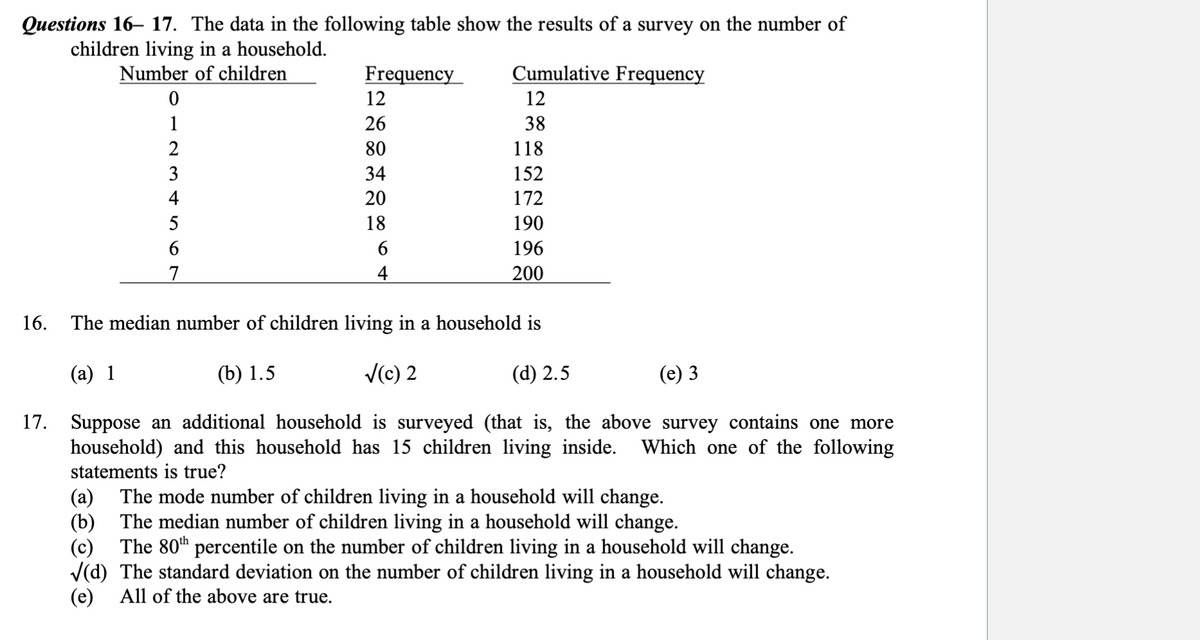Questions 16– 17. The data in the following table show the results of a survey on the number of children living in a household. Number of children Frequency Cumulative Frequency 12 12 1 26 38 80 34 2 118 152 172 3 4 20 18 190 6 196 7. 4 200 16. The median number of children living in a household is (a) 1 (b) 1.5 V(c) 2 (d) 2.5 (e) 3
Questions 16– 17. The data in the following table show the results of a survey on the number of children living in a household. Number of children Frequency Cumulative Frequency 12 12 1 26 38 80 34 2 118 152 172 3 4 20 18 190 6 196 7. 4 200 16. The median number of children living in a household is (a) 1 (b) 1.5 V(c) 2 (d) 2.5 (e) 3
Chapter1: Making Economics Decisions
Section: Chapter Questions
Problem 1QTC
Related questions
Question
Please help me to explain why we can get that answer. Thank you!

Transcribed Image Text:Questions 16– 17. The data in the following table show the results of a survey on the number of
children living in a household.
Number of children
Frequency
Cumulative Frequency
12
12
1
26
38
2
80
118
3
34
152
4
20
172
5
18
190
6
196
200
16.
The median number of children living in a household is
(a) 1
(b) 1.5
V(c) 2
(d) 2.5
(е) 3
Suppose an additional household is surveyed (that is, the above survey contains one more
household) and this household has 15 children living inside.
17.
Which one of the following
statements is true?
The mode number of children living in a household will change.
(b) The median number of children living in a household will change.
The 80h percentile on the number of children living in a household will change.
(a)
(c)
V(d) The standard deviation on the number of children living in a household will change.
All of the above are true.
(e)
Expert Solution
This question has been solved!
Explore an expertly crafted, step-by-step solution for a thorough understanding of key concepts.
Step by step
Solved in 2 steps

Recommended textbooks for you


Principles of Economics (12th Edition)
Economics
ISBN:
9780134078779
Author:
Karl E. Case, Ray C. Fair, Sharon E. Oster
Publisher:
PEARSON

Engineering Economy (17th Edition)
Economics
ISBN:
9780134870069
Author:
William G. Sullivan, Elin M. Wicks, C. Patrick Koelling
Publisher:
PEARSON


Principles of Economics (12th Edition)
Economics
ISBN:
9780134078779
Author:
Karl E. Case, Ray C. Fair, Sharon E. Oster
Publisher:
PEARSON

Engineering Economy (17th Edition)
Economics
ISBN:
9780134870069
Author:
William G. Sullivan, Elin M. Wicks, C. Patrick Koelling
Publisher:
PEARSON

Principles of Economics (MindTap Course List)
Economics
ISBN:
9781305585126
Author:
N. Gregory Mankiw
Publisher:
Cengage Learning

Managerial Economics: A Problem Solving Approach
Economics
ISBN:
9781337106665
Author:
Luke M. Froeb, Brian T. McCann, Michael R. Ward, Mike Shor
Publisher:
Cengage Learning

Managerial Economics & Business Strategy (Mcgraw-…
Economics
ISBN:
9781259290619
Author:
Michael Baye, Jeff Prince
Publisher:
McGraw-Hill Education